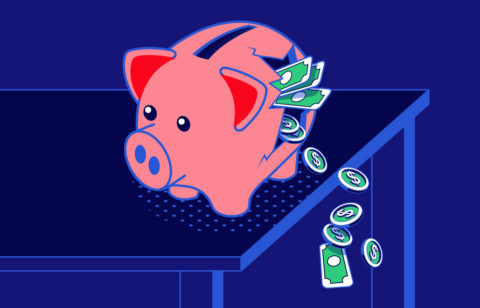What does financial happiness mean? Let’s start with what happiness is as a whole.
Being content or satisfied is the key to living a full life. This is something we all strive for. Our decisions are usually influenced by the things and events we know will feed our needs, emotions and souls.
But how does this reality impact our finances?
In this day and age, financial health is one of our personal measurements of success. How much money we have can impact how and where we live. When we have credit card debt, we want to pay it off to live a happier life. When we do not have enough money to finance all our expenses, we could feel down or even depressed.
We pursue a higher income so that the things we want, and need, are within reach. So, it is not really the money that makes us happy. It is what the money can buy.
Finding happiness in your personal finances
Here are a few reasons why your happiness includes building a strong financial foundation:
- Money is a measurement of your contentment. Pretty much everyone needs to have at least some possessions to enjoy their life. A car might seem like a luxury, but it’s actually a basic necessity for those who live in a rural area.
- Money builds confidence. There is something about being financially comfortable that makes you feel confident, especially when you know how hard you worked for your success.
- Money alleviates stress. A benefit of being financially confident is it removes a lot of financial stress. You will not fall short in financing most of your needs, and that is an important part of a fulfilling life.
- Money helps you control your future. Your money is a tool that allows you to pursue important life goals such as a comfortable retirement, proper education and nice living conditions.
Financial happiness is actually a state of mind. It comes from knowing you have the money to purchase the things that will make your life easier and better.
Remember, though, that while money can enhance your happiness, it can only do so to a certain extent. Many studies have found that it is important to have enough money to meet your basic needs. But beyond that level of wealth, accumulating additional money does not make as significant a contribution to your well-being as you might think.
Money is a resource that can help boost how you feel, but only when you use it correctly. When you apply money in the wrong ways or to the wrong areas of your life, it will not promote the life you seek. It could make you insatiable for more until enough is never enough.
The key is to remember that you need to achieve a certain level of wealth to purchase the necessities in life, but not much more than that. Once you achieve your financial goals, you can use cash to avoid debt and increase your quality of life.
Easy does it
Feeling content with your personal financial situation is easier than you think. The key is to focus on what is most important to you and ignore the rest. Food, shelter and clothing are the basics. You might envision a luxury vacation or a souped-up coupe as the icing on the cake. But if your financial situation is tenuous, focus on what you already have.
Here are the three truths you should know to achieve financial satisfaction:
It’s not about the debt, it’s about money management.
Many of us fear debt, especially if we have experienced financial difficulties in the past that have left us in the lurch. And such fears are not a bad thing because it keeps us in check. After all, most forms of debt are indeed destructive to our finances.
But did you know that there are also good forms of debt? For example, mortgages and student loans typically help us work toward a brighter future and a higher credit score.
So, while it is wise to avoid many forms of debt, others may be a necessary part of life. When this is the case it’s not the debt that is the issue, but how we manage it.
If you are in the market for a home, purchasing what you can afford makes the mortgage payments more manageable. The same goes for student loans—don’t borrow more than you need. Spending cautiously is another way to avoid overwhelming debt.
Making your debt payments on time, every time, will also keep you out of trouble. Eventually, you will pay off your debt and get your life back. It will all feel worthwhile if the result is owning a home with a small mortgage, or a college education that results in a lucrative career.
Sound money management is the key to maintaining control over your finances. Even if you spend your way into debt, knowing how to manage your money can prevent it from spiraling out of control.
It’s not about earning more, it’s about personal fulfillment.
A higher income can indeed make you happier, but only in some cases. If you hate your job or find that it leaves you unfulfilled, no amount of money is likely to satisfy you. And if it keeps you from enjoying your family life, it is too high of a price to pay.
The world is full of people who earn a big income but are not content. They work day and night chasing the American Dream, but still go home unhappy. That is because they are focused on the money, and not how they earned it or what it can buy.
When you find meaning in your daily work, it makes you happy. When you know that your work has a purpose, you will feel more satisfied – regardless of how much you are earning.
It’s not about your net worth, it’s about security.
Lastly, we need to break free of our obsession with growing net worth. It is true that being rich is a major achievement, but it is not a prerequisite to happiness.
When you are focused on increasing your net worth, you might obsess about the wrong things. You want more even though you have enough. After putting in 16-hour-a-day workweeks, you tire yourself out trying to reach a higher level of personal wealth. Is it worth it?
Enjoying the finer things in life is great. But that pursuit can be exhausting and lead you to miss out on the simple – but good – things in life. And you can’t make up for the time you missed with your family, friends and loved ones.
Concentrate on shoring up your financial security but don’t take it too far. Build your emergency fund and make putting money away for retirement a priority.
You might be more fortunate than you realize. It’s not about the numbers, concentrate on what you already have and how much more you really need. You might find that your happiness meter is fine just where it is.







